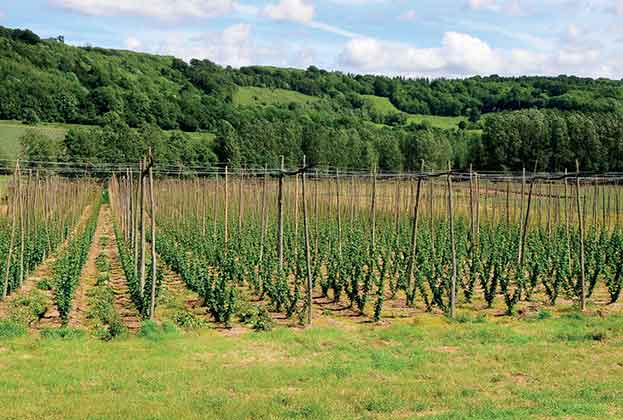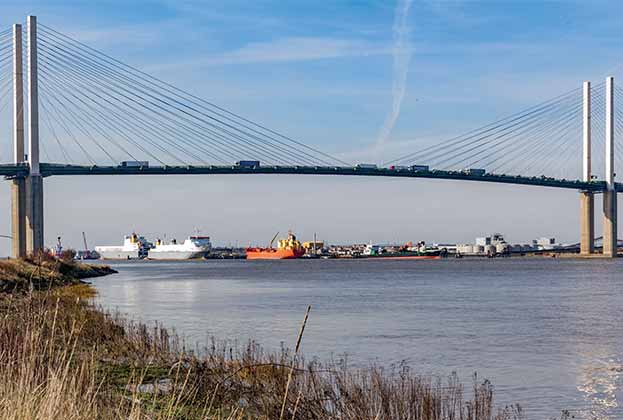Up-to-date Local Plans are required to coordinate infrastructure delivery and environmental mitigation, in order to meet housing need
Need and supply
The total target for annual housing delivery in Kent set in adopted and emerging local plans is 8,448. In 2020/21, net additional dwellings were not far off this figure, with a total of 8,308 homes added to the stock in the county. However, this aggregate masks some significant shortfall, both in the delivery against target in specific locations, and more challengingly in the number of homes being planned for.
The standard method for calculating housing need produces a requirement for Kent that is over 40% higher than the current local plan targets. Under-performing areas include Canterbury, where 438 homes were built in 2020/21 against a Local Plan target of 800 homes and a standard method requirement of 1,120 homes per year, and Sevenoaks, where housing delivery was 50 homes above the local plan target, but 500 homes below the standard method figure.
Kent is set to benefit from infrastructure improvements over the next decade that could unlock major development potential
Emily Williams, Director, Residential Research
As a consequence of this under delivery, several local planning authorities (LPAs) are facing sanctions under the Housing Delivery Test. Dover and Folkestone and Hythe must prepare an action plan to outline how the area will prevent future undersupply. Swale and Thanet are required to apply a 20% buffer to their five-year land supply. Canterbury, Gravesham, Sevenoaks, Tonbridge and Malling, and Medway all delivered less than 75% of their housing need and so must apply the presumption in favour of sustainable development to planning applications.
Opportunities
Kent is set to benefit from infrastructure improvements over the next decade that could unlock major development potential, the bulk of which will be focused in the north of the county. The Elizabeth Line is finally set to open on 24 May 2022. It will terminate at Abbey Wood, but a proposal was submitted to the government in November 2021 for the line to be extended to Gravesend. This would increase the frequency of services to Central London and provide better links with Canary Wharf, although it is unlikely to be delivered until the 2030s.
The area around Gravesend could also be boosted by the proposed Lower Thames Crossing. The new tunnel would double road capacity across the Thames, and bring over 400,000 jobs within a 60-minute commute of Gravesham and Thurrock, and linking with the London Gateway Deep Sea Port at Corringham. Construction of the Crossing itself will also provide an economic boost, with 22,000 new jobs created. The improved connectivity in the area is likely to draw buyers from Havering and Dartford, looking for more space and better value for money.
Much of these opportunities are driven by the area’s position as a strategic growth corridor in the London Plan. The newest London Plan states that the Mayor is interested in working with partners to accommodate more growth in sustainable locations outside the capital. The Thames Gateway from Dartford to Chatham and locations along the HS1 line are identified as areas of particular interest to support economic growth around Canary Wharf and London City Airport. Further economic growth in the area could come from the proposed Swanscombe Peninsula theme park, expected to create at least 20,000 new jobs.
.jpg)
Challenges
Although there should be plenty of new opportunities in Kent, land availability is a major constraint. According to Savills calculation, seven LPAs have a housing land supply of under five years. Green belt is a constraint on development in six LPAs, covering over 70% of land in three of them. In the last year, Medway, Sevenoaks and Tunbridge Wells have all been found at appeal to lack an adequate land supply. The East Sussex LPAs are similarly constrained, with three years or less of land supply identified in Eastbourne, Wealden and Hastings.
Local Plan progress is also proving challenging, particularly in the west of the area. Both Sevenoaks and Tonbridge and Malling have been required to restart the Local Plan process, as they were found to have failed in the duty to co-operate with surrounding local authorities. Both authorities now have no up to date Local Plan and have failed the most recent Housing Delivery Test, but the potential for speculative planning applications will be limited by the green belt and the Kent Downs AONB. These land constraint challenges are pushing the focus of development further east within Kent to traditionally lower-value areas.
But the most pressing difficulty is the issue of nutrient neutrality, which is affecting sites within the River Stour catchment. The local planning authorities in this area have been advised by Natural England that permission cannot be legally granted for developments that are not nitrate and phosphate neutral.
As a consequence of this, the number of homes receiving full planning permission in Kent has fallen from over 9,000 in 2017 to 5,800 in 2020. In Ashford, consents have fallen in that three-year period by 57%. Until mitigation schemes can be put in place in conjunction with rural landowners, nutrient neutrality will pose a significant obstacle to meeting housing need and supporting economic growth in Kent and the wider South East.
Read the articles within South East Development: Unlocking potential below
.jpg)

